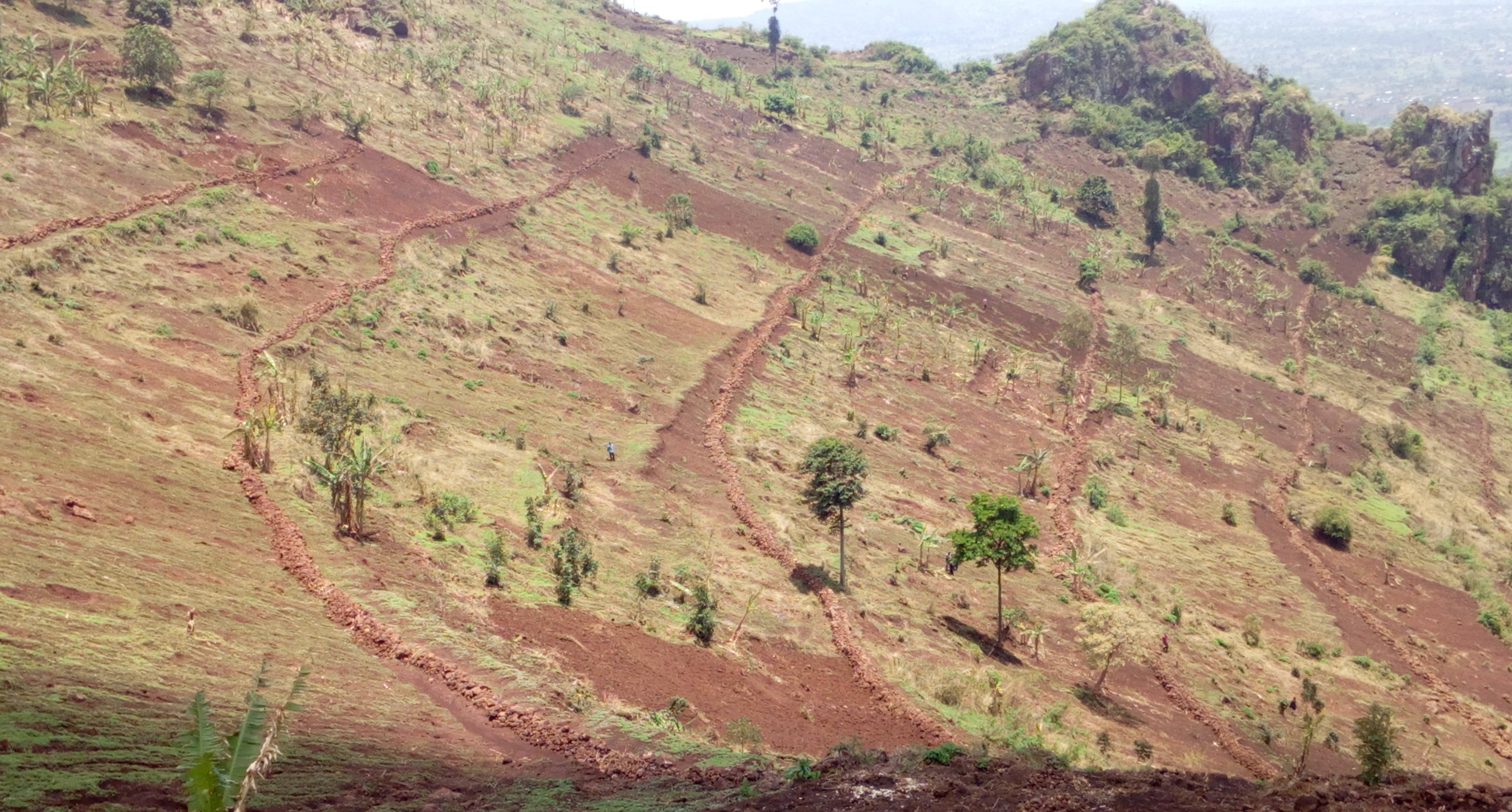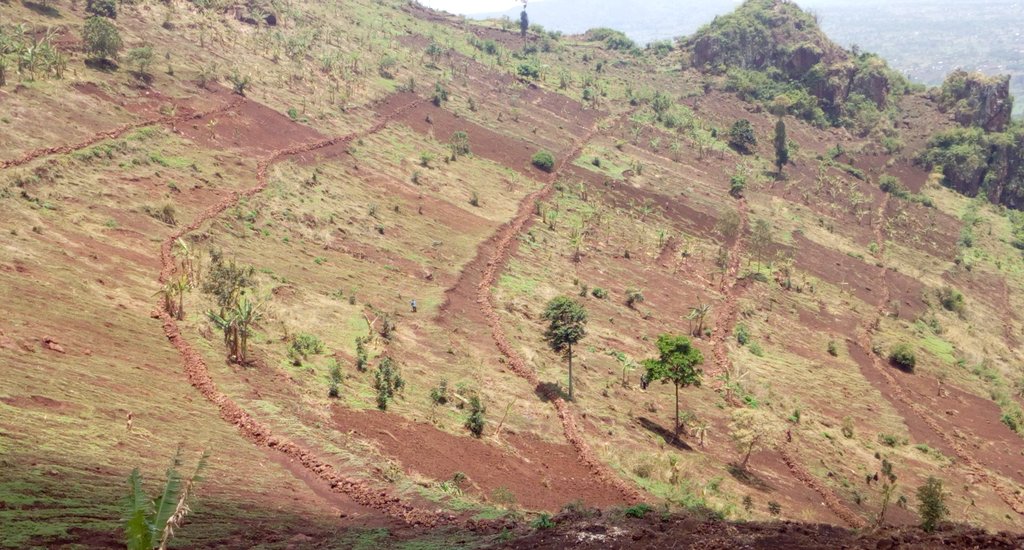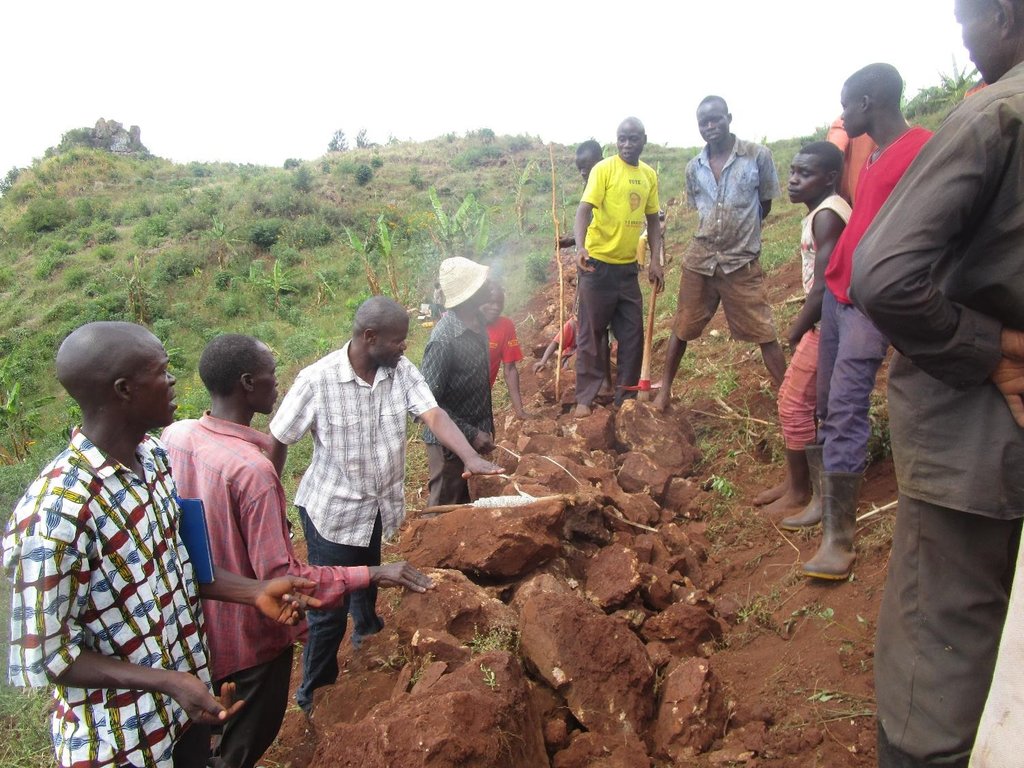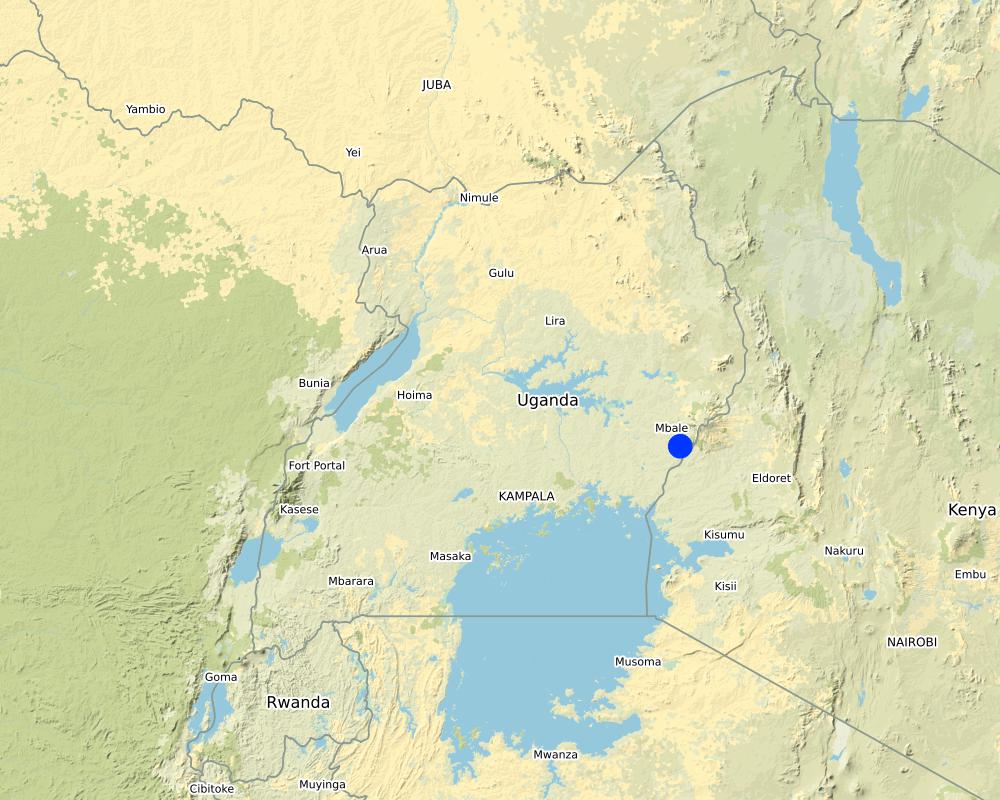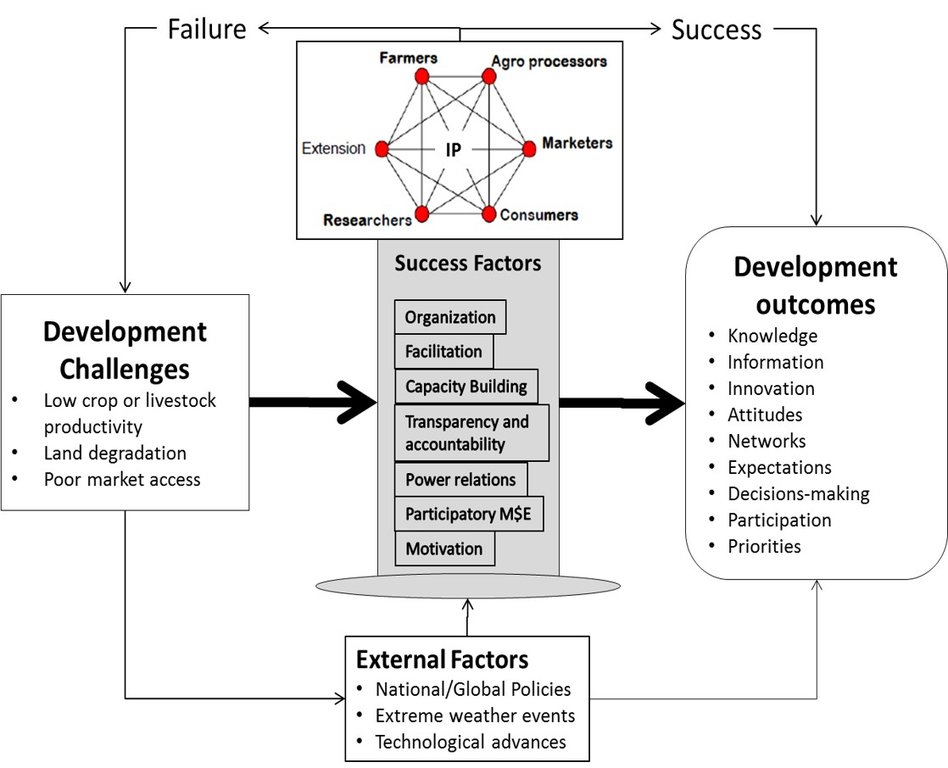Innovation Platform Approach (IPA) for Collective Action in SLM [Ouganda]
- Création :
- Mise à jour :
- Compilateur : Bernard Fungo
- Rédacteurs : Dr. Patrick Musinguzi, Moses Makooma Tenywa, Kamugisha Rick Nelson
- Examinateurs : Nicole Harari, Udo Höggel
Tubaana Group
approaches_4041 - Ouganda
Voir les sections
Développer tout Réduire tout1. Informations générales
1.2 Coordonnées des personnes-ressources et des institutions impliquées dans l'évaluation et la documentation de l'Approche
Nom du projet qui a facilité la documentation/ l'évaluation de l'Approche (si pertinent)
Scaling-up SLM practices by smallholder farmers (IFAD)Nom du ou des institutions qui ont facilité la documentation/ l'évaluation de l'Approche (si pertinent)
Uganda Landcare Network (ULN) - Ouganda1.3 Conditions relatives à l'utilisation par WOCAT des données documentées
Quand les données ont-elles été compilées (sur le terrain)?
12/09/2016
Le compilateur et la(les) personne(s) ressource(s) acceptent les conditions relatives à l'utilisation par WOCAT des données documentées:
Oui
2. Description de l'Approche de GDT
2.1 Courte description de l'Approche
Critical actors in a certain area come together, articulate the perceived challenge, identify solutions, allocate responsibilities and work together towards overcoming the challenge
2.2 Description détaillée de l'Approche
Description détaillée de l'Approche:
Efficient use of natural resources is a critical pathway to achieving green growth. Mountain ecosystems are an example of natural resources that need to be sustainably managed to continue providing economic, social and environmental benefits to the large number of dependent communities. The challenge is that these ecosystems are fragile and highly susceptible to natural disasters and their management requires multi-sectoral, transboundary, interdisciplinary and landscape level interventions. Although several technologies to address land degradation exist, adoption remains low. This has been attributed mainly to a dysfunctional extension system and weak implementation of land management policies/regulations. Working at landscape-scale and ensuring inter-sectoral coordination and cooperation is crucial for effective land management responses.
An Innovation Platform (IP) approach is a mechanism to enhance communication and innovation capacity among mutually dependent actors, by improving interactions, coordination, and coherence among all actors to facilitate learning and contribute to production and use of knowledge. The IP approach is a coalition, collaboration, partnership and alliance of agricultural research and development (ARD) actors. That is, public and private scientists, extension workers, representatives of farmers, farmers’ associations, private firms and non-governmental organizations and government policy makers.
Documentation of this approached is based on experience from a study conducted in the eastern highlands of Uganda. The aim of this study was to improve the understanding of how IPs can enhance adoption of soil and water conservation technologies in the fragile highland ecosystems of eastern Uganda. Control of soil erosion was identified as a challenge to be addressed by the IP. The process involved the key principles as follows:
1. Establishment of an effective leadership – An IP committee was established and trained on critical skills required in group dynamics
2. Facilitating formation of lower-level groups (IP clusters) – this is not a necessary step but was important to implement soil erosion control in Bugobero micro-catchments
3. Capacity building – mainly on soil erosion control using contour bunds stabilized with multipurpose trees (Calliandra and Grevillea). This was done through the Farmer Field School (FFS) approach. Farmers were able to collectively establish 4,000 meters of contour bunds and reduce run-off and erosion significantly
4. Participatory Monitoring and Evaluation
5. Development and implementation of an effective communication strategy among stakeholder; and
6. Facilitating the formulation of by-laws to foster implementation of soil erosion control. A by-law on maintenance of the established contour bunds was initiated and the process is still on-going.
From this experience, the IP intends to implement the FFS approach on other technologies such as fodder-bank establishment from Calliandra along contours bunds, manure management for production and collective marketing of bananas. These interrelated technologies are contributing towards improving the banana value chain, which plays a significant role in the food and income security of a majority of households in eastern Uganda. Data collection on information flow and knowledge sharing among stakeholders is on-going to provides empirical evidence about the potential of this approach. The benefits demonstrated by the IP are a motivation for stakeholders to participate in collective action. The cycle of benefits can lead to a self-sustaining community.
The need to establish an IP can originate from various actors including researchers, farmers, development agencies, NGOs, private companies, entrepreneurs and agricultural artisans, among others. Once a common challenge has been identified, the vision bearer can begin to mobilize other actors and share visions.
The advantages of this approach include:
1. direct and continuous interaction, communication and knowledge sharing among the IP actors
2. quick and continuous feedback from end users (farmers) at all stages of research for development and;
3. timely integration of new knowledge into the innovation process using experiential learning, monitoring and evaluation and the continous feedback
One limitation of this approach is that it requires continuous motivation of the various actors to maintain their interest the IP. Often times the benefits of Natural Ressources Management, NRM are long-lived while most actors look for shorter term benefits, making it difficult to maintain motivation. Conflict is a common occurrence in such multi-stakeholder platforms and only transparent and accountable leadership can overcome this. Examples of situation where conflict situations arise include technology selection, labour distribution, financial and gender biases.
2.3 Photos de l'approche
2.5 Pays/ région/ lieux où l'Approche a été appliquée
Pays:
Ouganda
Région/ Etat/ Province:
Manafwa District, Mount Elgon Region
Autres spécifications du lieu :
Khabungu Parish, Bugobero Sub county
Commentaires:
The site is located on the southern slopes of Mt Elgon
Map
×2.6 Dates de début et de fin de l'Approche
Indiquez l'année de démarrage:
2016
2.7 Type d'Approche
- fondé sur un projet/ programme
2.8 Principaux objectifs de l'Approche
Improve knowledge-sharing and dialogue among relevant actors in addressing a multi-stakeholder natural resource management challenge
2.9 Conditions favorisant ou entravant la mise en œuvre de la(des) Technologie(s) appliquée(s) sous l'Approche
normes et valeurs sociales/ culturelles/ religieuses
- favorise
Social capital in form of community cohesiveness encourages people to support the less-privileged such as the elderly, who cannot afford labour to construct contour bunds on their own
disponibilité/ accès aux ressources et services financiers
- favorise
Several microfinance institutions have be created with support from government of Uganda to farmer groups, although their priority is not much into natural resource management
- entrave
Stringent rules on payback periods and collateral make it difficult for most farmer groups on SLM to access
cadre institutionnel
- favorise
Existence of several farmer groups can support knowledge sharing
- entrave
Enforcement of land management laws inadequate
collaboration/ coordination des acteurs
- favorise
Decentralization policy in the country
cadre politique
- favorise
Decentralization policy in Uganda allows for establishment of local rules of engagement between farmers and local government
connaissances sur la GDT, accès aux supports techniques
- favorise
Several NGOs and projects are promoting land management practices due to frequent occurrence of landslides in the area
- entrave
The largely demand-driven farmer-paid extension system in Uganda does not allow for farmers to seek technical support on land management practices
marchés (pour acheter les intrants, vendre les produits) et prix
- favorise
Increasing population in has driven up the demand for food and agricultural supplies and this creates new markets for farmers' produce
- entrave
The difficult terrain makes access to markets terribly difficult for farmers
charge de travail, disponibilité de la main-d'œuvre
- entrave
Shortage of labor due to youth migration to urban areas yet land management technologies are labor intensive
3. Participation et rôles des parties prenantes impliquées dans l'Approche
3.1 Parties prenantes impliquées dans l'Approche et rôles
- exploitants locaux des terres / communautés locales
Farmers
Implement land management practices on their farms
- Spécialistes de la GDT/ conseillers agricoles
Agricultural Extension staff
Provide technical advise to farmers
- chercheurs
National Agricultural Research Organization (NARO)
Study the technological, institutional and market approaches and processes for improving the functioning of the IP approach
- ONG
Mbale Coalition Against Poverty (Mbale-CAP)
Provision of farm inputs such as tree seedlings of appropriate species
- secteur privé
Input dealers, product dealers and banks
Provision of input such as seedlings to farmers and buying of produce such as bananas from farmers. Banks provide low-interest loans to farmers.
- gouvernement local
Sub county local government
Support the process of preparation and enactment of by-laws of land management
- organisation internationale
International Research Centers (e.g. World Agroforetry Center)
Support research by providing extra expertise to national research centers and sometime laboratory facilities where needed
Si plusieurs parties prenantes sont impliquées, indiquez l'organisme chef de file ou l'institution responsable:
National Forestry Resources Research Institute (NaFORRI), National Agricultural Research Organization (NARO)
3.2 Participation des exploitants locaux des terres/ communautés locales aux différentes phases de l'Approche
| Participation des exploitants locaux des terres/ communautés locales | Spécifiez qui était impliqué et décrivez les activités | |
|---|---|---|
| initiation/ motivation | soutien extérieur | Some groups had already initiated some actions but were not very progressive. A research team came from the the National Research Institute to stimulate the organization of the group on soil erosion control. |
| planification | interactive | Farmers participated in the elections to establish the steering committee of the IP. They also participated in the visioning and articulation of the soil erosion challenge and the means to address it. Farmers also participated in the selection of technological options for soil erosion control. |
| mise en œuvre | interactive | Local leaders (Local Councils) participated in the formation of lower level IP clusters in each sub catchment and mobilizing households to participate in joint activities on designated days. Farmers participated in the collective action to establish soil erosion control structures across the landscape. |
| suivi/ évaluation | interactive | Farmers and local leaders were part of the monitoring and evaluation committee of the IP and participated in periodic activities to asses progress towards the set targets such as the extent and quality of contour bunds completed, the rate of soil erosion and the performance of the crops after the bunds are created. |
3.3 Diagramme/ organigramme (si disponible)
Description:
Flow Chart of the process that the IP approach needs to go through to be effective
Auteur:
Bernard Fungo
3.4 Prises de décision pour la sélection de la Technologie/ des Technologies
Indiquez qui a décidé de la sélection de la Technologie/ des Technologies à mettre en œuvre:
- tous les acteurs concernés dans le cadre d'une approche participative
Expliquez:
Several meetings are held in which all actors deliberate the technological options available and a voting stage decides which of the options is to be selected for implementation. There are also situations when more than one option is considered if they do not contradict.
Spécifiez sur quelle base ont été prises les décisions:
- l'évaluation de connaissances bien documentées en matière de GDT (prises de décision fondées sur des preuves tangibles)?
- expériences et opinions personnelles (non documentées)
4. Soutien technique, renforcement des capacités et gestion des connaissances
4.1 Renforcement des capacités/ formation
Une formation a-t-elle été dispensée aux exploitants des terres/ autres parties prenantes?
Oui
Spécifiez qui a été formé:
- exploitants des terres
Formats de la formation:
- zones de démonstration
Thèmes abordés:
Soil erosion control using contour bunds, types of bunds, size and spacing between them
4.2 Service de conseils
Les exploitants des terres ont-ils accès à un service de conseils?
Oui
Spécifiez si le service de conseils est fourni:
- dans les champs des exploitants?
- dans des centres permanents
Décrivez/ commentez:
Where the demonstration lots are established, technical staff visit the site and provide support on-site. The zonal research center is also available for interested farmers to visit and learn more about the technological options suitable for the area.
4.3 Renforcement des institutions (développement organisationnel)
Des institutions ont elles été mises en place ou renforcées par le biais de l'Approche?
- oui, modérément
Spécifiez à quel(s) niveau(x), ces institutions ont été renforcées ou mises en place:
- local
- national
Décrivez l'institution, ses rôles et responsabilités, ses membres, etc.
National Agricultural Advisory Services (NAADS) operates at district level through formation and training of farmers groups. Mainstream extension workers at the sub-counties provide training to farmers and farmers groups that are not part of the NAADS groups. The training was augmented by NARO and other NGOs.
Précisez le type de soutien:
- renforcement des capacités/ formation
- équipement
Donnez plus de détails:
The IP actors, including local government staff, farmer groups and extension staff were trained on various aspects of group dynamics in order to improve their management skills. The sub-county local government was provided with tools (pangas, mattocks and hoes) for use in establishing stone lines.
4.4 Suivi et évaluation
Le suivi et l'évaluation font ils partie de l'Approche? :
Oui
Si oui, ce document est-il destiné à être utilisé pour le suivi et l'évaluation?
Non
4.5 Recherche
La recherche a-t-elle fait partie intégrante de l’Approche?
Oui
Spécifiez les thèmes:
- sociologie
- économie/ marketing
- technologie
Donnez plus de détails et indiquez qui a mené ces recherches:
One of the objectives of the research was to understand how the IP processes can be improved to achieve more positive development outcomes (e.g. knowledge, attitude change). The other objective was to find out how effective short-rotation shrubs would perform in stabilizing contour bunds for soil erosion control in hillsides. The economic study aimed at assessing the marginal income from establishing contour bunds for soil erosion control.
5. Financement et soutien matériel externe
5.1 Budget annuel de la composante GDT de l'Approche
Si le budget annuel précis n'est pas connu, indiquez une fourchette:
- 2 000-10 000
Commentez (par ex. principales sources de financement/ principaux bailleurs de fonds):
Support from Global Environmental Facility (GEF), through NARO
5.2 Soutiens financiers/ matériels fournis aux exploitants des terres
Les exploitants des terres ont-ils reçu un soutien financier/ matériel pour la mise en œuvre de la Technologie/ des Technologies?
Oui
Si oui, spécifiez le(s) type(s) de soutien, les conditions et les fournisseurs:
Tools and implements for establishing contour bunds (hoes, pangas, mattocks)
5.3 Subventions pour des intrants spécifiques (incluant la main d'œuvre)
- aucun
Si la main d'œuvre fournie par les exploitants des terres était un intrant substantiel, elle était:
- récompensée avec un autre soutien matériel
Commentaires:
Each household owning land in the micro catchment was allowed access to the tools whenever needed. The tools were stored in a joint place where all farmers in the micro-catchment would have access to.
5.4 Crédits
Des crédits ont-ils été alloués à travers l'Approche pour les activités de GDT?
Non
5.5 Autres incitations ou instruments
D'autres incitations ou instruments ont-ils été utilisés pour promouvoir la mise en œuvre des Technologies de GDT?
Non
6. Analyses d'impact et conclusions
6.1 Impacts de l'Approche
Est-ce que l'Approche a autonomisé les exploitants locaux des terres, amélioré la participation des parties prenantes?
- Non
- Oui, un peu
- Oui, modérément
- Oui, beaucoup
Training provided on technological options for soil erosion control and leadership training to local leaders. All stakeholders contributed to the selection of appropriate technologies.
Est-ce que l'Approche a permis la prise de décisions fondées sur des données probantes?
- Non
- Oui, un peu
- Oui, modérément
- Oui, beaucoup
Farmers were part of the establishment of the contour bunds and also part of the M&E committee. Field days organized were used to show evidence of effectiveness of contour bunds at landscape level.
Est-ce que l'Approche a aidé les exploitants des terres à mettre en œuvre et entretenir les Technologies de GDT?
- Non
- Oui, un peu
- Oui, modérément
- Oui, beaucoup
Farmers were able to establish 4000 meters of contour bunds in one of the micro catchments
Est-ce que l'Approche a amélioré la coordination et la mise en œuvre de la GDT selon un bon rapport coût-efficacité?
- Non
- Oui, un peu
- Oui, modérément
- Oui, beaucoup
Various stakeholders were able to meet in one place and collectively discuss a common challenge of soil erosion
Est-ce que l'Approche a mobilisé/ amélioré l'accès aux ressources financières pour la mise en œuvre de la GDT?
- Non
- Oui, un peu
- Oui, modérément
- Oui, beaucoup
Est-ce que l'Approche a amélioré les connaissances et les capacités des exploitants des terres pour mettre en œuvre la GDT?
- Non
- Oui, un peu
- Oui, modérément
- Oui, beaucoup
Both the training and demonstration site on soil erosion enlightened land users about the various soil erosion control practices
Est-ce que l'Approche a amélioré les connaissances et les capacités des autres parties prenantes?
- Non
- Oui, un peu
- Oui, modérément
- Oui, beaucoup
The other stakeholders appreciated the importance of collective action at landscape level after soil erosion was reduced significantly
Est-ce que l'Approche a construit/ renforcé les institutions, la collaboration entre parties prenantes?
- Non
- Oui, un peu
- Oui, modérément
- Oui, beaucoup
Extension staff, researcher and local government were able to realize the technologies generated by NARO such as Calliandra for livestock, which had not been known to local leaders before
Est-ce que l'Approche a atténué les conflits?
- Non
- Oui, un peu
- Oui, modérément
- Oui, beaucoup
Est-ce que l'Approche a autonomisé les groupes socialement et économiquement défavorisés?
- Non
- Oui, un peu
- Oui, modérément
- Oui, beaucoup
Est-ce que l'Approche a amélioré l'égalité entre hommes et femmes et autonomisé les femmes et les filles?
- Non
- Oui, un peu
- Oui, modérément
- Oui, beaucoup
Est-ce que l'Approche a encouragé les jeunes/ la prochaine génération d'exploitants des terres à s'engager dans la GDT?
- Non
- Oui, un peu
- Oui, modérément
- Oui, beaucoup
Est-ce que l'Approche a amélioré les questions foncières et des droits d'utilisation qui entravent la mise en œuvre des Technologies?
- Non
- Oui, un peu
- Oui, modérément
- Oui, beaucoup
Est-ce que l'Approche a conduit à améliorer la sécurité alimentaire et/ou la nutrition?
- Non
- Oui, un peu
- Oui, modérément
- Oui, beaucoup
Improvements in yield of bananas and maize was reported. This is part of food security improvement.
Est-ce que l'Approche a amélioré l'accès aux marchés?
- Non
- Oui, un peu
- Oui, modérément
- Oui, beaucoup
Traders participated in the IP with the hope of accessing a steady supply of bananas at stable prices if farmers agree to sign contracts with them. This commitment was not binding and did not show much success.
Est-ce que l'Approche a conduit à l'utilisation/ sources d'énergie plus durables?
- Non
- Oui, un peu
- Oui, modérément
- Oui, beaucoup
Est-ce que l'Approche a amélioré la capacité des exploitants des terres à s'adapter aux changements/ extrêmes climatiques et a atténué les catastrophes liées au climat?
- Non
- Oui, un peu
- Oui, modérément
- Oui, beaucoup
Before the project, soil erosion destroyed property and killed people in the catchment but this was avoided after the project implemented contour bunds. Heavy rains no longer affect the people negatively.
Est-ce que l'Approche a conduit à des emplois, des opportunités de revenus?
- Non
- Oui, un peu
- Oui, modérément
- Oui, beaucoup
6.2 Principale motivation des exploitants des terres pour mettre en œuvre la GDT
- réduire les risques de catastrophe
Soil erosion used to destroy property but has now been managed by establishing contour bunds in the slopes. This is the major achievement of the project that farmers always refer to.
- améliorer les connaissances et compétences en GDT
Stakeholders were exposed to various methods of controlling run-off and soil erosion
6.3 Durabilité des activités de l'Approche
Les exploitants des terres peuvent-ils poursuivre ce qui a été mis en œuvre par le biais de l'Approche (sans soutien extérieur)?
- oui
Si oui, décrivez de quelle manière:
After realizing the benefits, farmers can be encouraged to work together to maintain the soil erosion control structures. Local leaders can ensure that the by laws are enforced to ensure compliance by land owners.
6.4 Points forts/ avantages de l'Approche
| Points forts/ avantages/ possibilités du point de vue de l'exploitant des terres |
|---|
| The approach ensures that every land user implements the soil erosion control structures since erosion affects everyone |
| Collective action is good because where some land users are unable to comply, either rules are enforced or they are supported to comply |
| Points forts/ avantages/ possibilités du point de vue du compilateur ou d'une autre personne ressource clé |
|---|
| Direct and continuous interaction, communication and knowledge sharing among the IP actors |
| Quick and continuous feedback from end users (farmers) at all stages of research and extension |
| Timely integration of new knowledge into the innovation process using experiential learning, monitoring and evaluation and the continual feedback from stakeholders |
6.5 Faiblesses/ inconvénients de l'Approche et moyens de les surmonter
| Faiblesses/ inconvénients/ risques du point de vue de l’exploitant des terres | Comment peuvent-ils être surmontés? |
|---|---|
| Sometimes some farmers do not approve of the technology being promoted and choose not to participate in collective action | Allowing for multiple options for addressing the same challenge is important in encouraging collective action |
| Lack of transparency and committed leadership can discourage participation | Capacity building on effective leadership is important |
| Faiblesses/ inconvénients/ risques du point de vue du compilateur ou d'une autre personne ressource clé | Comment peuvent-ils être surmontés? |
|---|---|
| It requires continuous motivation of the various actors to maintain their interest the IP. Often times the benefits of NRM are long-lived while most actors look for shorter term benefits, making it difficult to maintain motivation. | The leadership should properly articulate the short term as well as the long term benefits of the approach |
| Conflict is a common occurrence in such multi-stakeholder platforms and only transparent and accountable leadership can overcome this | Implementing the effective communication strategy is important in ensuring transparency and reducing distrust ad conflict situations |
7. Références et liens
7.1 Méthodes/ sources d'information
- visites de terrain, enquêtes sur le terrain
Up to 10 field visits over a one year period during the implementation of the proejct
- interviews/entretiens avec les exploitants des terres
A household survey of 200 households in the Bugobero sub county
7.2 Références des publications disponibles
Titre, auteur, année, ISBN:
Integrated Agricultural Research for Development ...from concept to practice, ISBN: 978-9988-1-1639-0
Disponible à partir d'où? Coût?
http://ciat-library.ciat.cgiar.org/Articulos_Ciat/biblioteca/Integrated_agricultural_research_for_development_from_concept_to_practice.pdf
7.3 Liens vers les informations pertinentes disponibles en ligne
Titre/ description:
Guidelines for innovation platforms: Facilitation, monitoring and evaluation
URL:
http://citeseerx.ist.psu.edu/viewdoc/download?doi=10.1.1.856.4244&rep=rep1&type=pdf
Liens et modules
Développer tout Réduire toutLiens
Aucun lien
Modules
Aucun module trouvé


